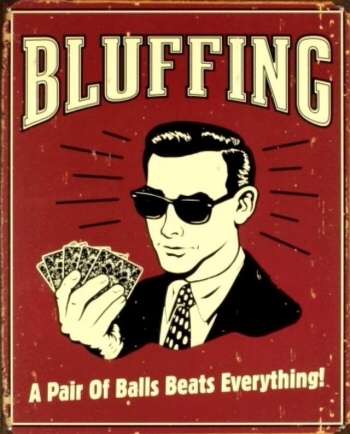5 Types of Bluff in NLH Poker

5 Types of Bluff in NLH Poker
One of the most exciting and popular aspects of live and online poker is bluffing. There’s nothing better to taking down a huge pot with Ax or 72 suited, in fact at some sites such as UB.com you can even win jackpots for doing this.
However, although bluffing on TV and movies makes it look like a basic tactic for winning chips, bluffing is actually one of the key ways in which professional players gain an edge over their opponents.
In general, we talk about five types of bluffs in poker. Below, I’ll provide a summary of each type of bluff and how to use it effectively.
Continuation Betting: By far one of the most common bluffs in online poker. A continuation bet is when a player bluffs the board having made the last raise pre-flop. For example, if a player raises pre-flop with AKo and makes a bet on the flop 7-9-2. The main advantage of continuation betting is that it gives you initiative in the hand, gives you a good chance of your opponents folding, and allows you to semi-bluff a wide range of hands to balance your range with.
Pure Bluff: The “pure bluff” is when you make a big bet or shove all-in with nothing, hoping that your opponent(s) in the hand will fold. Although the pure bluff usually requires the biggest commitment of chips (out of all of the bluffs) since you need enough fold equity to bluff your opponent off the pot, it also screams as the most “weak”. The pure bluff tends to be used very frequently by new players who miss their draw on the river and hope to pure bluff their opponent as a last ditch attempt. Overall, I wouldn’t recommend using the pure bluff unless you have excellent reading abilities on your opponent’s strength – and know that he’s capable of folding.
The Semi-Bluff: The semi-bluff is similar to a pure bluff however you normally have “outs” in case you get called. It’s very common to semi-bluff the flop or turn for example with a combo-draw like Qd-Jd on a 10s-5d-Kd board. The main advantage of semi-bluffing is that you can use it with a wide range of hands when you have position on your opponent. It gives you initiative in the hand, camouflages your hand strength, and gives you greater implied odds for when you get called and improve your hand.
Check-Raise Bluff: The check-raise bluff is quite advanced compared to the other bluffs and can only be used against loose-aggressive opponents. A check-raise bluff is when you feign “weakness” by checking your hand out of position, waiting for your opponent to raise, then re-raising him. You generally don’t want to check-raise your opponent until later on in the hand, since otherwise you’d be giving information about the strength of your hand too early. Alternatively, you could also “bluff-raise” your opponent which is when you make a check-raise with a weaker hand in the hope that he will fold.
The Post-Oak Bluff: You’re unlikely to ever use the post-oak bluff since it’s the trickiest to pull off successfully. A post-oak bluff is when you min-bet the river (1/4 pot or less) with a weak hand, making it look as though you have a really strong hand that you want your opponent to call. Your opponent realises this and folds his hand thinking that you have him beat. The massive risk here is that your opponent will either call your min-raise for pot value, or even re-raise you.
This article was produced for us by MobileCasinoBonus.org




